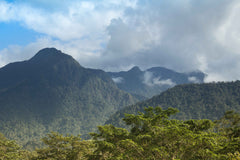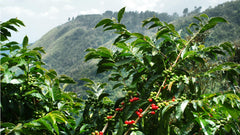
Coffee is the world's second most traded commodity after oil with nearly half a trillion cups consumed each year. Not only used for brewing a cup of joe, the coffee bean provides caffeine for beverages, pharmaceuticals, and cosmetics. The International Coffee Organization has named the following ten nations as the world's top producers of coffee:
10. GUATEMALA - 224,871 tons
 Guatemala launched its foray into coffee production primarily to find a suitable export that would replace indigo and cochineal, two of their early exports rendered useless once chemical dyes were invented in the 1800s. To provide support to the fledgling coffee industry, the government provided trade and tax benefits. In the 1960's the government looked to increase global demand for Guatemalan coffee through the establishment of Anacafé, a marketing association that continues to promote the nation's coffee worldwide.
Guatemala launched its foray into coffee production primarily to find a suitable export that would replace indigo and cochineal, two of their early exports rendered useless once chemical dyes were invented in the 1800s. To provide support to the fledgling coffee industry, the government provided trade and tax benefits. In the 1960's the government looked to increase global demand for Guatemalan coffee through the establishment of Anacafé, a marketing association that continues to promote the nation's coffee worldwide. 9. MEXICO - 257,240 tons
 Mexico confronted a coffee crisis in the 1990s when the International Coffee Agreement was dismantled and worldwide coffee prices and export quotas were no longer strictly controlled. Essentially, Mexico became unable to compete in the global market. The decline in coffee prices and production led to lost income and created social issues throughout the nation. While coffee production declined over the 90s and into the 2000s, steady demand from the United States has led to a recovery in the Mexican coffee market, from an all-time low of 1.7 million bags in 2005 to 4 million in 2014.
Mexico confronted a coffee crisis in the 1990s when the International Coffee Agreement was dismantled and worldwide coffee prices and export quotas were no longer strictly controlled. Essentially, Mexico became unable to compete in the global market. The decline in coffee prices and production led to lost income and created social issues throughout the nation. While coffee production declined over the 90s and into the 2000s, steady demand from the United States has led to a recovery in the Mexican coffee market, from an all-time low of 1.7 million bags in 2005 to 4 million in 2014. 8. UGANDA - 314,489 tons
 The nation's top-earning export, coffee is a vital part of the Ugandan economy since a large portion of the population works in coffee related industries. Coffee production was initially an unsuccessful venture until the government allowed privatization in 1991. A strong revival in the industry has led to a 5100% increase in production since 1989.
The nation's top-earning export, coffee is a vital part of the Ugandan economy since a large portion of the population works in coffee related industries. Coffee production was initially an unsuccessful venture until the government allowed privatization in 1991. A strong revival in the industry has led to a 5100% increase in production since 1989. 7. HONDURAS - 380,296 tons
 Having ascended to Central America's top spot in coffee production, Honduras continues to struggle with national branding. Nevertheless, coffee remains a vital part of the Honduran economy since the coffee industry provides employment to a large segment of the population and likely kept the nation's economy afloat during the 2009 political crisis.
Having ascended to Central America's top spot in coffee production, Honduras continues to struggle with national branding. Nevertheless, coffee remains a vital part of the Honduran economy since the coffee industry provides employment to a large segment of the population and likely kept the nation's economy afloat during the 2009 political crisis.
6. INDIA - 385,786 tons
 Since much of the country is unsuitable for growing coffee, the majority of production occurs in the hilly tracts of south Indian states. Coffee is grown by small growers in monsoon rainfall conditions and often planted among cardamom and cinnamon that imbue the beans with spice-laden flavors and aroma. As one might expect, coffee is not the beverage of choice in a country of 1.25 billion people who prefer tea. Consequently, 80% of India's coffee is exported primarily to Europe and Russia.
Since much of the country is unsuitable for growing coffee, the majority of production occurs in the hilly tracts of south Indian states. Coffee is grown by small growers in monsoon rainfall conditions and often planted among cardamom and cinnamon that imbue the beans with spice-laden flavors and aroma. As one might expect, coffee is not the beverage of choice in a country of 1.25 billion people who prefer tea. Consequently, 80% of India's coffee is exported primarily to Europe and Russia.
5. ETHIOPIA - 423, 287 tons
 As the birthplace of coffee, Ethiopia enjoys a rich coffee culture and employs roughly 15 million of its people in coffee production. Since early domestication of the plant, regional variants of the Arabica bean have been developed each with its own varietal character. The Harar, Limu, Sidamo, and Yirgacheffe beans are trademarked variations of the Arabica bean with the ownership rights protected by the government of Ethiopia.
As the birthplace of coffee, Ethiopia enjoys a rich coffee culture and employs roughly 15 million of its people in coffee production. Since early domestication of the plant, regional variants of the Arabica bean have been developed each with its own varietal character. The Harar, Limu, Sidamo, and Yirgacheffe beans are trademarked variations of the Arabica bean with the ownership rights protected by the government of Ethiopia. 4. INDONESIA - 814,629 tons
 Indonesia’s mountainous regions, volcanic soil, and microclimate offer ideal conditions for coffee cultivation. Introduced to coffee by Dutch colonists, Indonesia maintains over one million hectares of coffee plantations with roughly 90% of the cropland worked by small-scale producers.
Indonesia’s mountainous regions, volcanic soil, and microclimate offer ideal conditions for coffee cultivation. Introduced to coffee by Dutch colonists, Indonesia maintains over one million hectares of coffee plantations with roughly 90% of the cropland worked by small-scale producers.3. COLOMBIA - 892,871 tons
 Second only to Brazil in terms of coffee production for years, Colombia has been overtaken by Vietnam recently due to its rapidly expanding production. Colombia’s size alone certainly contributes to the different profiles that its 20 coffee-growing departments express in the cup. Yet even within growing regions there are distinct variations due to the microclimates created by mountainous terrain, wind patterns, proximity to the Equator, and, of course, differences in varieties and processing techniques. Colombia remains a highly regarded origin that produces exceptional coffee.
Second only to Brazil in terms of coffee production for years, Colombia has been overtaken by Vietnam recently due to its rapidly expanding production. Colombia’s size alone certainly contributes to the different profiles that its 20 coffee-growing departments express in the cup. Yet even within growing regions there are distinct variations due to the microclimates created by mountainous terrain, wind patterns, proximity to the Equator, and, of course, differences in varieties and processing techniques. Colombia remains a highly regarded origin that produces exceptional coffee.2. Vietnam - 1,818,811
 Despite an understandable downturn in coffee production during and after the Vietnam War, coffee has remained a huge part of the Vietnamese economy. The country’s only greater export is rice. Vietnam’s rapid expansion in coffee production is evident in its increased yield: 6,000 tons in 1975 to nearly 2 million tons today.
Despite an understandable downturn in coffee production during and after the Vietnam War, coffee has remained a huge part of the Vietnamese economy. The country’s only greater export is rice. Vietnam’s rapid expansion in coffee production is evident in its increased yield: 6,000 tons in 1975 to nearly 2 million tons today. 1. Brazil - 2,859,502 tons
 Brazil has remained the dominant global producer of coffee for over 150 years. Its coffee plantations span nearly 27,000 square kilometers with the majority located in Minas Gerais, Sao Paulo, and Parana, three southeastern states recognized for microclimates that offer prime conditions for coffee cultivation. Brazil is unique among other coffee producing nations by its sole use of dry processing in which coffee cherries are sun dried rather than washed to expose the coffee beans.
Brazil has remained the dominant global producer of coffee for over 150 years. Its coffee plantations span nearly 27,000 square kilometers with the majority located in Minas Gerais, Sao Paulo, and Parana, three southeastern states recognized for microclimates that offer prime conditions for coffee cultivation. Brazil is unique among other coffee producing nations by its sole use of dry processing in which coffee cherries are sun dried rather than washed to expose the coffee beans.